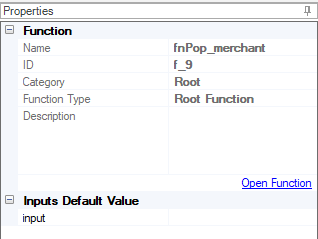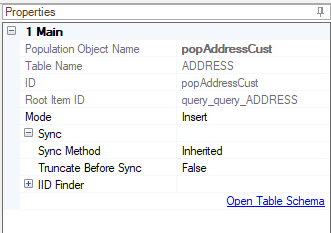Table Population Properties Tab
The Properties Tab in the Table Population window displays additional information about different objects in the Population window, as follows:
- DB query or Root function Source Objects.
- Target LU table.
- Other objects of a Table Population transformation like a Translation or Global.
- Properties of any selected field in a Population object.
Since each object has different properties, the tab’s layout is updated to display them when an object is selected in the map.
The properties include:
- Basic information about the Population object. For example, Name or ID.
- Specific properties of each object. For example, sync method of target LU table.
- Link to open the object. For example, to edit the query or the function.
- Input arguments (source only) or the Inputs default value, if applicable.
Source Object - DB Query Properties
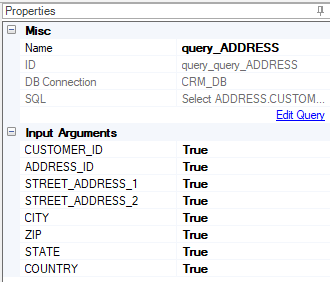 |
Name, displays the DB query name. Editable field. ID, generated by Fabric. DB Connection, displays the DB interface of the Source Object. Non-editable. SQL, displays the query. To edit it, click the Edit Query link. Edit Query, link to the Query Builder. Input Arguments , displays a list of Input arguments which are all True by default. The fields that should be linked to the parent table are set to True. Other fields that do not need to be linked to a parent table can be set to False. In the DB query of a root table, only one field can be defined as True and is populated by the Instance ID. |
Function Properties
The Function Properties tab displays the properties of either a source Root function or any Project function in the population.
Target LU Table Properties
Translation Properties
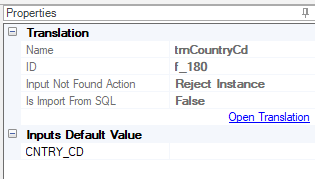 |
Name, displays the function name. Non-editable. ID, generated by Fabric. Input Not Found Action, indicates the system’s behavior when a matching Translation is not found. There are four options: Use Default / Reject Record / Reject Instance / Report and Use Default. Is Import From SQL, False / True. Indicates whether the translation data was imported from SQL or not. Open Translation, link to open the Translation window. Inputs Default Value, displays the Input parameters of the Translation. A default value can be defined for each Input field that can be used if there is no link connected to the field or when an Input value = Null. To remove the default value, right click the field and select either Clear Value or Set as Empty String. |
Global Properties
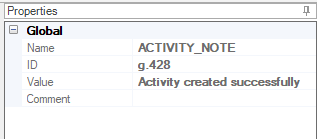 |
Name, displays the Global name. Non-editable. ID, generated by Fabric. Value, displays Global value. Non-editable. Comment. |
Constant Properties
 |
Name, displays the Constant name. Editable field. ID, generated by Fabric. Value, displays the Constant value. Editable field. |
Lookup Properties
Table Population Properties Tab
The Properties Tab in the Table Population window displays additional information about different objects in the Population window, as follows:
- DB query or Root function Source Objects.
- Target LU table.
- Other objects of a Table Population transformation like a Translation or Global.
- Properties of any selected field in a Population object.
Since each object has different properties, the tab’s layout is updated to display them when an object is selected in the map.
The properties include:
- Basic information about the Population object. For example, Name or ID.
- Specific properties of each object. For example, sync method of target LU table.
- Link to open the object. For example, to edit the query or the function.
- Input arguments (source only) or the Inputs default value, if applicable.
Source Object - DB Query Properties
 |
Name, displays the DB query name. Editable field. ID, generated by Fabric. DB Connection, displays the DB interface of the Source Object. Non-editable. SQL, displays the query. To edit it, click the Edit Query link. Edit Query, link to the Query Builder. Input Arguments , displays a list of Input arguments which are all True by default. The fields that should be linked to the parent table are set to True. Other fields that do not need to be linked to a parent table can be set to False. In the DB query of a root table, only one field can be defined as True and is populated by the Instance ID. |
Function Properties
The Function Properties tab displays the properties of either a source Root function or any Project function in the population.
Target LU Table Properties
Translation Properties
 |
Name, displays the function name. Non-editable. ID, generated by Fabric. Input Not Found Action, indicates the system’s behavior when a matching Translation is not found. There are four options: Use Default / Reject Record / Reject Instance / Report and Use Default. Is Import From SQL, False / True. Indicates whether the translation data was imported from SQL or not. Open Translation, link to open the Translation window. Inputs Default Value, displays the Input parameters of the Translation. A default value can be defined for each Input field that can be used if there is no link connected to the field or when an Input value = Null. To remove the default value, right click the field and select either Clear Value or Set as Empty String. |
Global Properties
 |
Name, displays the Global name. Non-editable. ID, generated by Fabric. Value, displays Global value. Non-editable. Comment. |
Constant Properties
 |
Name, displays the Constant name. Editable field. ID, generated by Fabric. Value, displays the Constant value. Editable field. |



